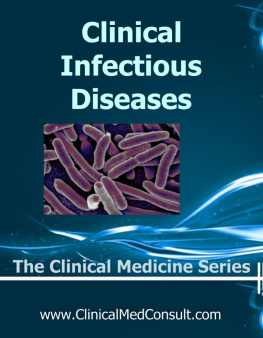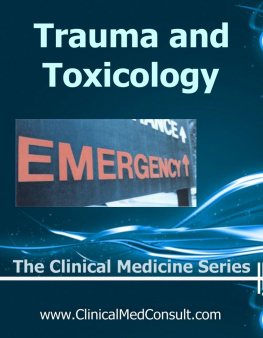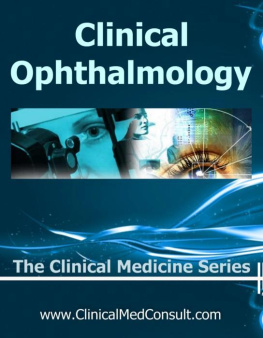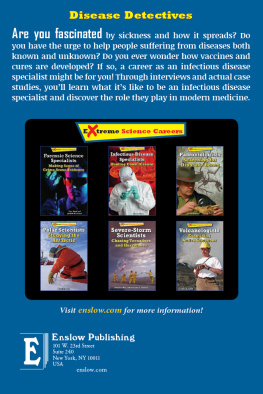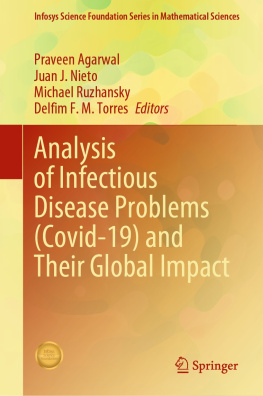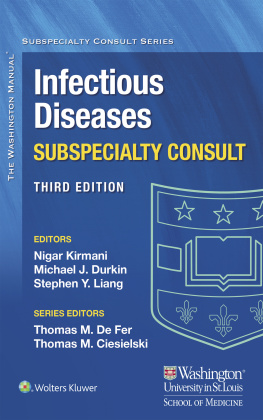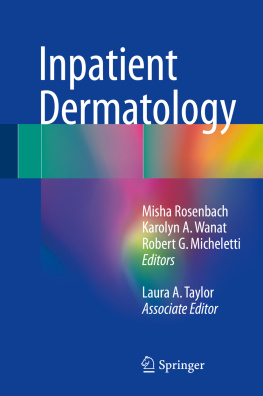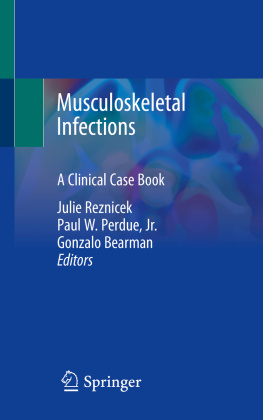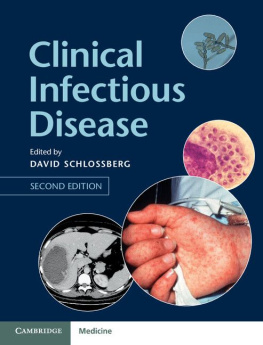Infectious Diseases
Contents:|
Primary editor Stephen Hosea, MD, IDSpecialist.
Last updated on 30 OCT2019
http://clinicalmedconsult.com/
Weperform an ongoing review of most major journals, textbooks, and other online resources.Ongoing scientific information is added as the new and clinically relevantevidence is released. This is the only point of care medical reference createdfor portable electronic devices in a concise and compact format by physiciansand for physicians. The goal of this text is to bring all of the clinicallyrelevant information clinicians need during patient care directly to one'sfingertips. |
TheClinical Medicine Consult includes all 35 of our modules in the clinical medicine series in one highly integrated text . All of these textsare in full 264k color. Currently the total illustrations / diagrams / color photos stands at >4,784. The iSilo version ofthis text comes with free quarterly updates for one year. Both the Kindle andiSilo versions can be read / utilized on just about any portable device (androidphone / tablet or iPhone, iPad etc), with the appropriate reader installed (getat your app store).
Introduction
Topics: Info| Microbiology | Syndromic Panels |
At anelementary level, the physician needs answers to 3 very basic questions fromthe laboratory: Is my patient's illness caused by a microbe? If so, what is it?What is the susceptibility profile of the organism so therapy can be targeted?See |
Infectious disease hospitalizations in the United States increased by more than6% between 1998 and 2006 (Clin Infect Dis 2009;49:1025-1035).....However,hospital deaths due to infections have been declining......The largestproportion of hospitalizations for infectious diseases occurred in the wintermonths, and lower respiratory tract infections were the most common diagnoses.
In thelast 35 years, mortality from most major infectious diseases declined (by 19%)in the U.S. but differed substantially among counties; the burden of diseasewas highest in the Southern U.S. (JAMA 2018;319:1248). Mortality has declinedin part because of improvements in healthcare and sanitation. Six infectiousdiseases: lower respiratory infections, HIV/AIDS, diarrheal diseases,hepatitis, meningitis, and tuberculosis which together accounted for 95.5% oftotal infectious diseases deaths. In 2014, lower respiratory infections werethe leading cause of infectious diseases mortality, accounting for 79%, andvaried the most in absolute numbers among counties, with counties in Louisiana,Arkansas, Alabama, Tennessee, Kentucky, and Georgia having the highestmortality. Diarrheal diseases were the second leading cause of infectiousdiseases mortality in 2014, with an increase of almost 500% between 1980 and2014 and increases seen in nearly all counties. HIV/AIDS caused 7% ofinfectious disease deaths in 2014 and had the highest relative between-countyinequalities. The mortality rates for lower respiratory tract infections, HIV,and meningitis in 2014 were all highest in the Southeast U.S. Hepatitismortality was highest in parts of California, Oregon, Texas, and New Mexico.Although tuberculosis was responsible for only 0.75% of infectious diseasesdeaths in 2014, counties in Southern and Southwestern U.S. had the highesttuberculosis mortality.
Forcommunity-acquired infection, Infectious disease (ID) specialists advice onantibiotic nonuse or discontinuation, and recommendations for performingmonitoring tests were associated with improved outcomes (J Antimicrob Chemother2010;65:156).....Physicians' adherence to the ID specialists' recommendationswas 88% for antibiotic treatment and 72% for diagnostic or monitoringtests......Following ID specialists' recommendations for antibiotic treatmentwas associated with a higher rate of early clinical improvement (61% vs. 44%;P<0.01) and a shorter median length of stay (20 vs. 23 days; P<0.03);in-hospital mortality was not affected......Adherence to recommendations forperforming diagnostic or monitoring tests had no significant effect on clinicaloutcomes.
Eachoutpatient practice should identify an infection prevention leader asoutpatient facilities currently perform more than 75% of all surgicalprocedures and the average number of outpatient visits to physician offices was3 per person per year (CDC. Guide to Infection Prevention for OutpatientSettings: Minimum Expectations for Safe Care. Published online July 13,2011)....Other recommendations for outpatient facilities and practicesinclude the following:
Infectionprevention and occupational health programs should be developed, implemented,and maintained.
Writteninfection prevention policies and procedures, based on evidence-basedguidelines, regulations, or standards, should be developed to address servicesprovided by each facility.
Allhealthcare personnel, including those employed by outside agencies andavailable by contract or on a volunteer basis to the facility, should receivejob- or task-specific infection prevention education and training focusing onprinciples of both healthcare provider safety and patient safety.
Sufficientand appropriate supplies needed to comply with standard precautions shouldalways be available. These precautions should include hand hygiene, use ofpersonal protective equipment, safe injection practices, respiratoryprecautions, cough etiquette, and environmental cleaning and maintenance ofreusable medical equipment according to the maker's instructions.
Staff'scompliance with infection prevention practices should be monitored regularlywith audits and competency evaluations.
Toevaluate infection control practices, facilities should use CDC's infectionprevention checklist for outpatient settings.
Facilitiesshould comply with local, state, and federal requirements regarding HAIsurveillance, reportable diseases, and outbreak reporting.
Healthcarepersonnel should always follow procedures to ensure safe handling of medicalequipment that may be contaminated.
Healthcarepersonnel should always follow safe medical injection practices.
Additionalresources, including the guide, checklist, continuing medical education course,CDC and external commentary about the guide, clinician and patient educationmaterials, a CDC Safe Surgery feature, and other supporting materials areavailable in the guidelines.
Guidelines: Twoseparate analyses presented here at the Infectious Diseases Society of America(IDSA) 47th Annual Meeting revealed that most of the society's treatmentguidelines are based on expert opinion, nonrandomized trials, and case studies(Infectious Diseases Society of America (IDSA) 47th Annual Meeting: Abstract1324. presented November 1, 2009; Abstract LB-31, presented October 31,2009).....Only about 15% of the guidelines are supported by randomizedcontrolled trials (RCTs), considered the highest level ofevidence.....Nonetheless, more than 40% of the guidelines' recommendations wereclassified as class A, the strongest level of treatment recommendation.
Microbiology
Microbiologyis the study of living organisms that can be so small that they cannot be seenby the naked eye. Microorganisms (bacteria, fungi, viruses, and parasites) varyin size and a variety of different types of microscopes are used to visualizethem.
A simplelight microscope can magnify an object up to approximately 400 times and isoften used to see bacteria, fungi, and parasites. A sophisticated electronmicroscope, which can magnify up to approximately 10,000 times, is needed tovisualize viruses which are about 5001000 times smaller than bacteria.
Pathogen: amicroorganism capable of invading the body and causing disease. There arethousands of different microorganisms, but only about 400 different species ofbacteria, fungi, viruses, and parasites cause infection in humans. These aretermed pathogens and they possess different properties that allow them toovercome the immune response and develop clinical infection. Such microorganismsare called pathogenic and their ability to cause disease is due to theirvirulence or pathogenicity.
Next page
